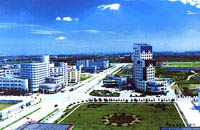 Approved in December 1984, Nantong Economic and Technological
Development Zone is one of the first national economic and technological
development zones in China.
Approved in December 1984, Nantong Economic and Technological
Development Zone is one of the first national economic and technological
development zones in China.
Geographical Location
The Nantong Economic &
Technology Development Zone, located in the middle part alongside China's
coastline and on the northern bank of the estuary of the Yangtze River, is an
important sea gate of this drainage area.
Climate
The Nantong Economic & Technology Development
Zone is of a humid subtropical monsoon climate, mild and with four distinctive
seasons. Its annual temperature averages 14.9 degrees centigrade and the annual
average precipitation is 1,066.8 milimeters.
Communication and Transportation
Harbor
The
Nantong Port is one of the ten largest ports in China, with 45 berths of various
kinds, including 28 ten-thousand-ton ones. Nangtong Port is open to navigation
to 199 ports in 65 countries and regions such as the USA, Russia, Canada,
Australia, Japan, Singapore, and has opened three lines for international
container shipment, namely the Hong Kong Line, the Japan Line and the South
Korea Line, with 28 regular container vessel liners shipping to various parts of
the world every day. At present, this port has an annual handling capacity of
over 23,000,000 tons, and an annual container transportation volume of 160,000
TEU, as well as well developed river transportation capacity.
Airport
The Nantong Economic & Technology
Development Zone is 100 kilometers away from the Shanghai Hongqiao International
Airport, 150 kilometers away from the Shanghai Pudong International Airport, 240
kilometers away from the Nanjing Lukou Airport, and 16 kilometers away from the
Nantong Airport. The Nantong Airport now operates airlines between Nantong and
the following cities, namely Beijing, Dalian, Guangzhou, Shenzhen, Qingdao and
Xiamen.
Road
It is less than three hours' drive along
the Ning Tong Expressway from the Nantong Economic & Technology Development
Zone to Nanjing. Before the Su-Tong Yangtze River Bridge was built, a drive to
Shanghai via a car ferry would take about two hours, covering a land distance of
100 km.
Railway
The Nantong section of the Xinchang
Railway, which has been put into operation after the completion of construction,
has a direct connection to the Nantong Economic & Technology Development
Zone, so does the Ningqi Railway about to be constructed.
Industrial Structure
Electronic communications, textile
fabrics and new chemical materials are the three leading industries.
Investment Priorities
Volume handling capacity projects,
including projects of new building materials, heavy machinery, shipping,
metallurgy, electric power, food processing, foodstuff processing and projects
in need of a base for storage such as warehousing, transshipment , trade and
whole sale market.
New and high-tech projects, including projects of new materials (new chemical
and synthetic materials such as structural type of materials and functional type
of materials, special fibre- use colophony, new electronic materials, new
ceramics materials, alloy material and nami materials), new medicines, animal
and plant protection, and seed engineering.
Projects for upgrading traditional industries, including projects that can
improve the traditional industries of Nantong and the Nantong Economic &
Technology Development Zone, namely the textile industry, the clothing industry
and the fine chemical industry of.
Science and technology intensive or Labor intensive projects, including
projects of processing the spare parts of electronic and communications
products.
Administration Committee
Tel: 86-531-3596030
Fax:
86-531-3596033
Email: info@netda.com
Website: www.netda.com
(Source: Ministry of Commerce)
(For more biz stories, please visit Industry Updates)